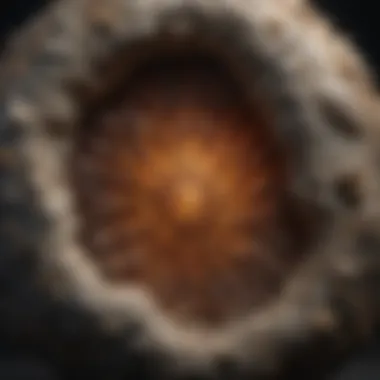Unveiling the Intricacies of Pouring Molds for Rock and Fossil Collectors


Rock and Fossil Identification
For rock and fossil collectors, the first step in the journey of pouring molds is understanding the types of rocks and fossils they may encounter. It is essential to have a keen eye for spotting key characteristics that distinguish one specimen from another. Collectors should familiarize themselves with the various tools used in rock and fossil identification, such as magnifying glasses, UV lights, and hardness testing kits.
Collecting Tips and Techniques
Once the rocks and fossils are identified, collectors can delve into the best practices for collecting these specimens. They should research and locate prime collecting sites known for their rich geological diversity. Safety is paramount during specimen extraction, requiring delicate handling to avoid damaging the rocks or fossils while retrieving them from their natural habitat.
Preservation and Display
Following the collection of specimens, enthusiasts must master techniques for preserving their rock and fossil treasures. Proper storage methods, such as using acid-free containers to prevent decay, are crucial for maintaining the integrity of the specimens. Additionally, collectors can get creative in displaying their rocks and fossils, incorporating them into decor or educational exhibits.
Geological Insights
To truly appreciate the art of pouring molds, rock and fossil collectors benefit from understanding the geological insights behind these specimens. Studying the formations and processes that shaped the rocks and fossils offers a deeper appreciation for their beauty and significance. Delving into the historical context and notable discoveries in the field adds another layer of fascination to the world of geological collecting.
Understanding the Basics of Pouring Molds
Pouring molds is a meticulous craft that holds significant importance for enthusiasts in the field of rock and fossil collection. It serves as the foundational step in replicating intricate specimens with precision and accuracy. Understanding the basics of pouring molds is crucial as it sets the groundwork for successful mold creation and specimen replication. By delving into the materials needed, preparing the specimen adequately, and creating a suitable mold box, enthusiasts can ensure a seamless molding process.
Materials Needed for Pouring Molds
Silicone Rubber
Silicone rubber plays a pivotal role in the pouring mold process due to its exceptional flexibility and durability. It serves as the primary molding material, providing the necessary elasticity to capture intricate details of rock and fossil specimens. The key characteristic of silicone rubber is its ability to withstand high temperatures, ensuring optimal mold performance. Enthusiasts gravitate towards silicone rubber for its reliable performance and ease of use, making it a popular choice in mold-making. One unique feature of silicone rubber is its tear resistance, which minimizes the risk of mold deformities during the pouring process.
Catalyst
The catalyst, a vital component in mold-making, catalyzes the curing process of the silicone rubber. It accelerates the setting time of the rubber, enabling efficient mold creation. The key characteristic of a catalyst is its reactive nature, initiating the polymerization of silicone rubber when mixed thoroughly. Enthusiasts appreciate the catalyst for its role in expediting the curing process, allowing for faster mold production. However, a potential disadvantage of the catalyst is its sensitivity to temperature variations, requiring precise measurement and handling to achieve optimal results.
Mixing Containers
Mixing containers are essential in ensuring the thorough blending of silicone rubber and catalyst for uniform consistency. These containers come in various sizes to accommodate different mold volumes, providing flexibility in mold-making. The key characteristic of mixing containers is their durability and non-reactive nature, preventing unwanted chemical interactions during the mixing process. Enthusiasts choose mixing containers for their ease of use and efficient mixing capabilities, contributing to the seamless preparation of mold materials.


Preparing Your Specimen for Molding
Cleaning the Specimen
The initial step of preparing a specimen involves thorough cleaning to remove any debris or impurities that may affect the mold quality. Cleaning the specimen ensures a smooth molding process, free from unwanted blemishes or irregularities. The key characteristic of cleaning the specimen is its role in enhancing mold accuracy and detail replication. Enthusiasts value this step for its impact on the final mold outcome, as a clean specimen contributes to a high-quality mold with intricate features. However, a potential disadvantage of cleaning is the time and effort required for thorough specimen preparation, highlighting the meticulous nature of mold-making.
Securing it in Place
Securing the specimen in place is essential to prevent movement or shifting during the molding process. This step ensures that the specimen retains its desired position within the mold box, maintaining alignment for accurate replication. The key characteristic of securing the specimen is its ability to stabilize the specimen, eliminating potential distortions in the mold. Enthusiasts prioritize this step to preserve the specimen's integrity and achieve precise mold detailing. However, a challenge in securing the specimen lies in finding suitable positioning techniques that maintain stability without damaging the specimen, requiring careful consideration and planning.
Creating a Mold Box
Choosing the Right Size
Selecting the appropriate size for the mold box is crucial in accommodating the specimen and silicone rubber mixture effectively. The chosen size should allow sufficient space for the specimen while ensuring a border for the silicone rubber to form the mold. The key characteristic of choosing the right size is its impact on mold stability and uniformity. Enthusiasts opt for accurate sizing to prevent excess material waste and optimize mold formation. One unique feature of selecting the right size is achieving a balanced mold space, promoting efficient molding and preserving material resources.
Ensuring a Secure Fit
Ensuring a secure fit between the specimen and mold box is key to preventing leaks and maintaining mold integrity. A snug fit minimizes the risk of silicone rubber seepage, enhancing mold precision and detail retention. The key characteristic of a secure fit is its role in creating a seamless mold enclosure, reducing the likelihood of mold imperfections. Enthusiasts prioritize this aspect to achieve consistent molding results and minimize material wastage. However, challenges may arise in achieving a secure fit for irregularly shaped specimens, necessitating innovative solutions to ensure a tight seal and optimal mold performance.
The Art of Pouring the Mold
In the realm of rock and fossil collecting, the art of pouring molds holds a paramount position, serving as a cornerstone technique for replicating intricate specimens with utmost precision. This section delves deep into the meticulous process of pouring molds, shedding light on its vital role in preserving geological wonders for enthusiasts and researchers alike. By mastering the art of pouring molds, collectors can reproduce detailed replicas of rare finds, allowing for further study and appreciation of these natural marvels.
Mixing and Pouring the Silicone Rubber
Adding the Catalyst
Adding the catalyst is a critical step in the molding process, as it initiates the chemical reaction that transforms liquid silicone into a solid mold. The catalyst acts as a hardening agent, ensuring the mold sets accurately and durably. Its key characteristic lies in its precise measurement requirement, as even a slight deviation can affect the mold's quality. Choosing the right catalyst is crucial for achieving optimal results, underscoring why meticulous attention to detail is paramount in this phase. While the catalyst accelerates the curing process, improper handling can lead to subpar molds, emphasizing the need for careful and accurate measurement.
Stirring Thoroughly
Stirring the silicone rubber thoroughly is imperative to guarantee a uniform consistency throughout the mixture. Proper stirring disperses the catalyst evenly, promoting uniform hardening and reducing the likelihood of air pockets or uncured spots in the mold. The key characteristic of thorough stirring lies in the creation of a homogenous blend, essential for achieving a flawless mold. This meticulous process ensures that the silicone rubber cures uniformly, mitigating any potential defects that may compromise the final mold quality. While consistent stirring may seem laborious, its role in producing high-quality molds cannot be overstated.


Pouring Evenly
Pouring the silicone rubber evenly into the mold is a delicate yet crucial task that impacts the final outcome significantly. A smooth and consistent pour is essential to prevent air entrapment and ensure that the mold captures every detail of the specimen accurately. The key characteristic of pouring evenly lies in maintaining a steady flow rate, allowing the silicone rubber to fill the mold without creating air pockets or voids. This methodical approach guarantees that the mold replicates the specimen with precision, yielding a faithful representation of the original object. While pouring evenly demands patience and precision, its role in producing flawless molds is indispensable.
Refining Your Mold
Refining your mold is a crucial process in the art of pouring molds for rock and fossil collectors. This stage focuses on perfecting the mold to ensure accurate and detailed reproductions of your specimens. By refining the mold, collectors can enhance the overall quality and fidelity of the final castings. It is a meticulous task that requires attention to detail and precision to capture the intricate features of rocks and fossils effectively.
Trimming and Cleaning the Mold
Removing Excess Material
Removing excess material plays a pivotal role in refining the mold. This step involves trimming away any surplus silicone rubber that may affect the final casting. By eliminating the excess material, collectors can ensure that the mold fits snugly within the mold box, minimizing any potential leakage or imperfections during the pouring process. This meticulous approach guarantees a higher success rate in producing accurate and detailed replicas of specimens for collectors.
Cleaning the Mold Surface
Cleaning the mold surface is another essential aspect of refining the mold. Ensuring that the mold surface is free of debris, dust, or any contaminants is crucial for maintaining the quality of the final castings. By meticulously cleaning the mold surface, collectors prevent any unwanted particles from jeopardizing the detailing and texture of the replicas. This meticulous attention to cleanliness results in pristine and professional-looking moldings that accurately mirror the original specimens.
Adding Details and Features
Incorporating Fine Details
Incorporating fine details refines the mold by capturing the intricacies of the specimen. This meticulous process involves enhancing the mold to reproduce even the subtlest features of rocks and fossils. By focusing on incorporating fine details, collectors can create lifelike replicas that showcase the unique characteristics of each specimen. This attention to detail elevates the quality of the final castings, making them truly impressive and highly sought after by collectors.
Enhancing the Overall Finish
Enhancing the overall finish of the mold adds a layer of refinement to the final castings. By fine-tuning the texture and appearance of the mold, collectors can achieve a polished and professional finish that mirrors the original specimen convincingly. This process of enhancing the overall finish involves meticulous craftsmanship and a keen eye for detail to ensure that every aspect of the casting meets the collector's standards. The result is a series of impeccable replicas that reflect the beauty and complexity of the rocks and fossils being reproduced.
Advanced Techniques and Tips:
Pouring molds for rock and fossil collectors involves a meticulous process that goes beyond just the basic steps. Advanced techniques and tips play a crucial role in ensuring the quality and precision of the final molded specimen. These techniques require attention to detail and experience to master, making them essential for enthusiasts looking to elevate their molding skills. By delving into advanced techniques, collectors can create molds that capture even the most intricate details of their specimens.
Creating Multi-Piece Molds:


Planning the mold sections:
When it comes to pouring molds for rock and fossils, creating multi-piece molds is a sophisticated technique that allows for the replication of complex shapes and structures. Planning the mold sections involves meticulous consideration of the specimen's dimensions and intricacies to determine the most effective way to divide the mold. By strategically planning the mold sections, collectors can ensure that each part fits seamlessly together, resulting in a cohesive final mold ready for casting. This method is popular among experienced collectors due to its ability to capture intricate details with precision and accuracy, offering a level of sophistication that single-piece molds may not achieve.
Aligning for precise casting:
Aligning for precise casting is a critical aspect of creating multi-piece molds that cannot be overlooked. Ensuring that the different sections of the mold align perfectly is essential to avoid any imperfections or inconsistencies in the final casted specimens. This meticulous process guarantees that each part of the mold fits together seamlessly, allowing for accurate and high-quality casts. While aligning for precise casting requires patience and precision, the results it yields in terms of detailed and flawless castings make it a favored technique among perfection-seeking collectors.
Exploring Casting Materials:
Resin casting:
In the realm of pouring molds for rock and fossils, resin casting stands out as a popular choice among collectors for its versatility and durability. Resin casting allows for the creation of detailed and polished casts that accurately replicate the original specimen's texture and colors. The key characteristic of resin casting lies in its ability to capture fine details with remarkable clarity, making it a desirable option for collectors seeking high-fidelity reproductions. While resin casting offers superior quality and durability, it can be slightly more challenging to work with compared to other casting materials due to its specific curing requirements.
Plaster casting:
Another widely used casting material in the world of pouring molds is plaster casting, known for its ease of use and cost-effectiveness. Plaster casting is favored by collectors looking to create quick and simple reproductions of their specimens without compromising on quality. The key characteristic of plaster casting is its ability to set quickly, allowing for faster demolding and processing times. While plaster casting is ideal for beginners or those looking for a straightforward casting material, it may not provide the same level of detail and longevity as resin casting.
Troubleshooting Common Issues:
Dealing with incomplete molds:
An essential skill for any collector engaging in pouring molds is the ability to troubleshoot common issues such as dealing with incomplete molds. Incomplete molds can occur due to various factors, including improper mixing of the mold material or insufficient curing time. By understanding how to identify and rectify incomplete molds, collectors can salvage their projects and avoid wasting materials. Taking quick action to address incomplete molds can save valuable time and resources, ensuring that the final castings meet the desired quality standards.
Fixing tears or deformities:
Fixing tears or deformities in molds is a critical aspect of maintaining the integrity and accuracy of the casting process. Tears or deformities can occur during demolding or casting due to mishandling or improper mold preparation. Knowing how to repair these imperfections is essential for collectors to produce flawless casts that accurately reflect the original specimens. By addressing tears or deformities promptly and effectively, collectors can salvage their molds and ensure that each casting meets their quality expectations.
Preservation and Display
Preservation and display are crucial aspects for rock and fossil collectors to ensure the longevity and aesthetic appeal of their molded specimens. The preservation of these valuable items involves implementing proper storage techniques and preventive measures to avoid damage and deterioration. By upholding high standards in preservation and display, collectors can showcase their specimens proudly while safeguarding them for future generations to appreciate. It is essential to understand the importance of preservation and display in the context of this article, as it highlights the care and dedication that collectors invest in maintaining the integrity of their prized pieces.
Storing Your Molded Specimens
Proper Storage Techniques
Proper storage techniques play a fundamental role in maintaining the quality and condition of molded rock and fossil specimens. This specific aspect focuses on storing specimens in optimal environmental conditions, such as humidity levels, temperature control, and protection from direct sunlight. By utilizing airtight containers, moisture-absorbent materials, and appropriate shelving, collectors can shield their specimens from environmental factors that may lead to degradation. Proper storage techniques contribute significantly to the overall goal of preserving molded specimens, ensuring they remain pristine and intact for extended periods. The key characteristic of proper storage techniques lies in their ability to create a controlled environment that mimics natural conditions, keeping the specimens stable and free from harm. Collectors benefit from these techniques as they provide a secure and organized system for managing their valuable collections. The unique feature of proper storage techniques is their capacity to prevent mold growth, mineral leaching, and other forms of deterioration that can compromise the integrity of molded specimens. While employing proper storage techniques requires diligence and precision, the advantages far outweigh the effort, as collectors can enjoy well-preserved specimens that retain their original beauty.
Avoiding Damage
Avoiding damage is paramount to the conservation of molded rock and fossil specimens, as any form of harm can degrade the aesthetic appeal and scientific value of these artifacts. This specific aspect emphasizes the importance of careful handling, proper packaging, and strategic placement to prevent accidental breakage or wear. By employing padding materials, secure enclosures, and gentle handling procedures, collectors can shield their specimens from physical harm and external influences that may cause damage over time. Avoiding damage contributes significantly to the overall preservation and display of specimens, as it ensures that each piece remains in pristine condition for observation and study. The key characteristic of avoiding damage is its focus on proactive measures that mitigate risks and enhance the longevity of molded specimens, promoting their longevity and value. Collectors opt for avoiding damage as it minimizes the likelihood of repairs, replacements, or refinishing, thus preserving the authenticity and integrity of their collections. The unique feature of avoiding damage lies in its ability to prolong the lifespan of molded specimens by safeguarding them against potential threats, such as handling mishaps, environmental hazards, and storage inadequacies. While implementing strategies to prevent damage demands attention and expertise, the benefits of maintaining specimen integrity far outweigh the challenges, ensuring that collectors can enjoy their prized items for years to come.







